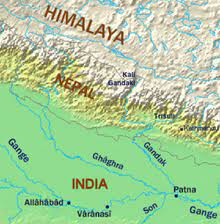The Ghaghara River is one of the major rivers in India and Nepal. It is a tributary of the Ganga River and flows through the states of Uttar Pradesh, Bihar in India, and in Nepal. The river is an important source of water for irrigation and provides an essential lifeline for the people living in its basin.

The Ghaghara River originates from the Tibetan plateau and flows through the Himalayas before entering the Gangetic plain. It is a perennial river and receives water from both snowmelt and monsoon rains. The river is known for its high silt content, which makes it difficult to navigate and causes frequent floods in the surrounding areas.
The River is an important river that flows through Bihar, a state located in eastern India. The river enters Bihar from the north and flows through the districts of West Champaran, Gopalganj, Siwan, Saran, and Vaishali before leaving the state and flowing into Uttar Pradesh.
In Bihar, the Ghaghara River is an important source of water for irrigation, providing water for agriculture and helping to support the state’s economy. The river also supports a diverse ecosystem, with a variety of aquatic plants and animals found in and around the river.
The Ghaghara River has played an important role in the history and culture of the region. It was once an important trade route, with goods being transported by boat from Nepal to the plains of India. The river has also been mentioned in ancient Indian texts, such as the Ramayana and the Mahabharata, and is considered a sacred river by many Hindus.
In recent years, the Ghaghara River has faced numerous environmental challenges, including pollution and dam construction. The river is also prone to frequent flooding, which can cause significant damage to crops and infrastructure in the surrounding areas.
To address these challenges, there have been various efforts to improve the management of the river. These include measures to reduce pollution, improve irrigation practices, and build infrastructure to mitigate the effects of flooding. The government has also established several programs to promote sustainable use of the river’s resources and to raise awareness about the importance of the river to the local communities.
In conclusion, the Ghaghara River is a vital resource for the people and ecosystems of the region. It has played an important role in the history and culture of the area and remains an essential source of water for irrigation and other uses. While the river faces numerous challenges, efforts are being made to ensure its sustainability for future generations.
Important Links